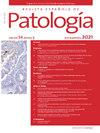通过常规体细胞NGS分析在各种肿瘤中鉴定DICER1的种系突变
IF 0.5
Q4 Medicine
引用次数: 0
摘要
DICER1综合征是一种遗传性疾病,使个体在广泛的年龄范围内易患多种具有不同组织病理特征的肿瘤。本研究提出了三个临床病例:一个新生儿与软骨间充质错构瘤,一个青少年胚胎性子宫颈横纹肌肉瘤,和一个妇女与松果体母细胞瘤。在所有肿瘤中,常规的下一代测序(NGS)研究检测到DICER1基因突变,提示生殖系参与,后来在外周血中使用Sanger测序证实了这一点。本文章由计算机程序翻译,如有差异,请以英文原文为准。
Identification of germline mutations in DICER1 through routine somatic NGS analysis in various neoplasms
DICER1 syndrome is a genetic disorder that predisposes individuals to developing a wide variety of neoplasms with different histopathological characteristics across a broad age range. This study presents three clinical cases: a newborn with a chondromesenchymal hamartoma, an adolescent with embryonal rhabdomyosarcoma of the cervix, and a woman with pineoblastoma. In all the tumours, a routine next-generation sequencing (NGS) study detected a mutation in the DICER1 gene, suggestive of germline involvement, which was later confirmed in peripheral blood using Sanger sequencing.
求助全文
通过发布文献求助,成功后即可免费获取论文全文。
去求助
来源期刊

Revista Espanola de Patologia
Medicine-Pathology and Forensic Medicine
CiteScore
0.90
自引率
0.00%
发文量
53
审稿时长
34 days
 求助内容:
求助内容: 应助结果提醒方式:
应助结果提醒方式:


